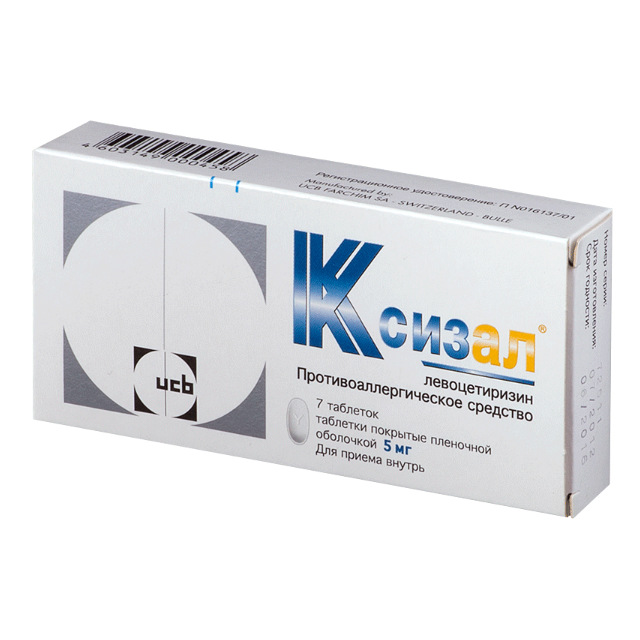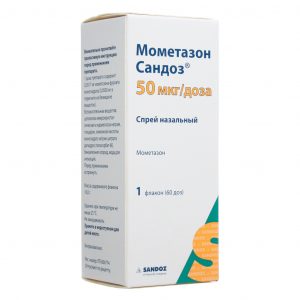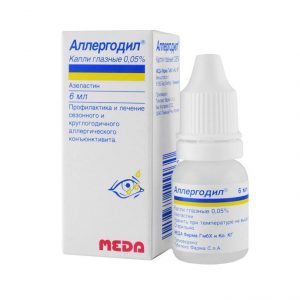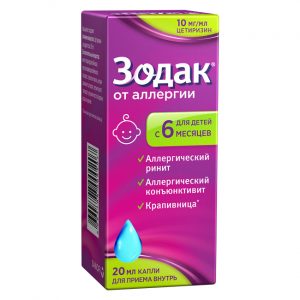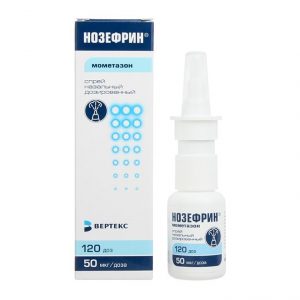Description
Release form
film-coated tablets.
Packing
7 pcs.
Pharmacological action
Xizal is an antiallergic drug.
The active substance of the drug is levocetirizine, the enantiomer of cetirizine, belongs to the group of competitive histamine antagonists. Levocetirizine has an effect on the histamine-dependent stage of allergic reactions, and also reduces the migration of eosinophils, reduces vascular permeability, limits the release of inflammatory mediators.
Prevents the development and facilitates the course of allergic reactions, has an antiexudative, antipruritic effect, practically has no anticholinergic and antiserotonin effect. In therapeutic doses, it has almost no sedative effect.
Indications
For adults and children over 6 years of age: treatment of symptoms of perennial and seasonal allergic rhinitis and allergic conjunctivitis, such as pruritus, sneezing, lacrimation, hyperemia of the hay fever conjunctiva (hay fever) of urticaria, including chronic idiopathic urticaria, Quincke edema, other allergic dermatoses, and accompanying.
Contraindications
Hypersensitivity to any component of the drug or piperazine derivatives. Severe form of chronic renal failure (creatinine clearance less than 10 ml / min). Children’s age (up to 6 years).
Precautions – chronic renal failure (dosage adjustment required), advanced age (possibly reduced glomerular filtration).
Special instructions
When objectively assessing the ability to drive a car and work with mechanisms, no undesirable phenomena were reliably detected when prescribing the recommended dose of 5 mg, nevertheless, it is advisable to refrain from engaging in potentially dangerous activities that require an increased concentration of attention and speed psychomotor reactions.
Composition
1 tablet contains 5 mg levocetirizine dihydrochloride.
Dosage and administration
Applied orally with food or on an empty stomach, washed down with a small amount of water, without chewing. Adults and children over 6 years: daily dose – 5 mg (1 tablet). Elderly patients (subject to normal renal function) dose reduction is not required. For patients with chronic renal failure, the dose is halved (1 tablet every other day) with CC from 30 to 49 ml / min and 3 times (1 tablet in 3 days) with CC from 10 to 29 ml / min. Patients with hepatic insufficiency do not need to adjust the dosage regimen.
Duration of administration depends on the disease. For the treatment of hay fever, an average of 1-6 weeks is prescribed. In chronic diseases (year-round rhinitis, atonic dermatitis), the duration of treatment can increase up to 18 months.
Side effects
Headache, drowsiness, dry mouth, fatigue. Rarely – migraine, dizziness, dyspeptic disorders, allergic reactions (angioedema, rash, urticaria, pruritus).
Drug Interactions
Concomitant use with macrolides or ketoconazole did not cause significant changes on the ECG. Joint administration with theophylline (400 mg / day) reduces the total clearance of levocetirizine by 16% (the kinetics of theophylline does not change).
When used in therapeutic doses, no data were obtained on interactions with alcohol. Nonetheless, it is necessary to refrain from the use of alcohol-containing drinks.
Overdose
Symptoms: may be accompanied by signs of intoxication in the form of drowsiness, in children an overdose of the drug may be accompanied by anxiety and increased irritability.
Treatment: if symptoms of an overdose appear (especially in children), the drug should be discontinued, gastric lavage, the use of activated charcoal, and symptomatic therapy are necessary. There is no specific antidote.
Storage conditions
In a dry place, at a temperature not exceeding 25 ° C.
Deystvuyuschee substances
Levocetirizine
Form of Treatment
tablets
Purpose
Adult, For children over 6 years
Indications
Allergic conjunctivitis, Itchy skin, Allergic rhinitis, Quincke’s edema, Pollinosis, Dermatosis, Nasal mucosal edema, Urticaria, Allergy
USB Farma S.A., Belgium
